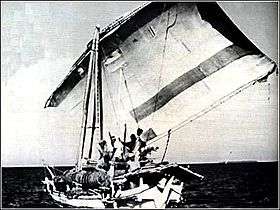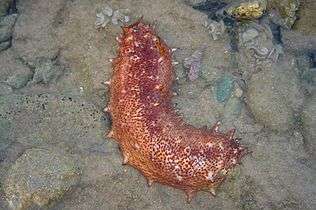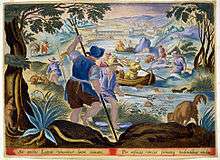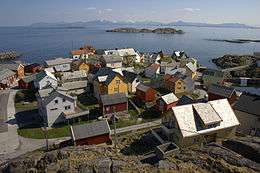Makassan contact with Australia

Makassan trepangers from the southwest corner of Sulawesi, Indonesia visited the coast of northern Australia "from at least the eighteenth century"[1] to collect and process trepang (also known as sea cucumber), a marine invertebrate prized for its culinary and medicinal values in Chinese markets. The term Makassan (or Macassan) is generally used to apply to all the trepangers who came to Australia, although some were from other islands in the Indonesian Archipelago, including Timor, Rote and Aru.
Fishing and processing of Trepang

The creature and the food product are commonly known as sea cucumber, bêche-de-mer in French, trepang (or trīpang) in Indonesian, gamat in Malaysian.[2]
Trepang live on the sea floor and are exposed at low tide. Fishing was traditionally done by hand, spearing, diving or dredging. The catch was placed in boiling water before being dried and smoked, to preserve the trepang for the journey back to Makassar and other South East Asian markets. Trepang is still valued by Chinese communities for its jelly-like texture, its flavour-enhancing properties, and as a stimulant and aphrodisiac.[3] Matthew Flinders made a contemporary record of how trepang was processed when he met a Makassan fleet in February 1803.[4]
The Voyage to Marege' and Kayu Jawa
Fishing fleets began to visit the northern coasts of Australia from Makassar in southern Sulawesi, Indonesia from about 1720, but possibly earlier. While Campbell Macknight's classic study of the Makassan trepang industry accepts the start of the industry as about 1720, with the earliest recorded trepang voyage made in 1751,[5] Regina Ganter of Griffith University notes a Sulawesi historian who suggests a commencement date for the industry of about 1640.[6] Ganter also notes that for some anthropologists, the extensive impact of the trepang industry on the Yolngu people suggests a longer period of contact. Arnhem land rock art, recorded by archaeologists in 2008, appears to provide further evidence of Makassan contact in the mid-1600s.[7] Contact has even been proposed from as early as the 1500s.[8]
At the height of the trepang industry, Makassans ranged thousands of kilometres along Australia's northern coasts, arriving with the north-west monsoon each December. Makassan perahu or praus could carry a crew of thirty members, and Macknight estimated the total number of trepangers arriving each year as about one thousand.[9] The Makassan crews established themselves at various semi-permanent locations on the coast, to boil and dry the trepang before the return voyage home, four months later, to sell their cargo to Chinese merchants.[10] Marege' was the Makassan name for Arnhem land, (meaning literally "Wild Country") from the Cobourg Peninsula to Groote Eylandt in the Gulf of Carpentaria. Kayu Jawa was the name for the fishing grounds in the Kimberley region of Western Australia, from Napier Broome Bay to Cape Leveque. Other important fishing areas included West Papua, Sumbawa, Timor and Selayar.[3] Matthew Flinders in his circumnavigation of Australia in 1803, met a Makassan trepang fleet near present day Nhulunbuy. He communicated at length with a Makassan captain, Pobasso, through his cook, who was also a Malay, and learned of the extent of the trade from this encounter.[4] Ganter adds: "1,000 Macassans...must have seen a veritable invasion against the fewer than 7,000 British nestled into Sydney Cove and Newcastle." [11] Nicholas Baudin also encountered 26 large perahu off the northern coast of Western Australia in the same year.[12] Ganter states that the British settlements of Fort Dundas and Fort Wellington were established as a result of Phillip Parker King's contact with Makassan trepangers in 1821.[11]
Using Daeng Rangka, the last Makassan trepanger to visit Australia, lived well into the 20th century and the history of his voyages are therefore well documented. He first made the voyage to northern Australia as a young man. He suffered dismasting and several shipwrecks, generally positive but occasionally conflicting relationships with Indigenous Australians, and was the first trepanger to pay the South Australian government trepanging licence in 1883, an impost that made the trade less viable.[13] The trade continued to dwindle toward the end of the 19th century, due to the imposition of customs duties and licence fees and probably compounded by overfishing.[3] Using Daeng Rangka commanded the last Makassar perahu, which left Arnhem Land in 1907.
Physical evidence of Makassan contact

Archeological remains of Makassar processing plants from the 18th and 19th centuries are still at Port Essington, Anuru Bay and Groote Eylandt, along with stands of the Makassan introduced tamarind trees. Macknight and others note these areas have produced pieces of metal, broken pottery and glass, coins, fishhooks and broken clay pipes.[14] Macknight notes that much of the ceramic material found suggests a nineteenth-century date.[15]
In 1916, two bronze cannons were found on a small island in Napier Broome Bay, on the northern coast of Western Australia. Scientists at the Western Australian Museum in Fremantle have made a detailed analysis and have determined that these weapons are swivel guns and almost certainly of late 18th century Makassan, rather than European, origin.[16] Flinders' account confirms that the Makassans he met were personally armed and their perahus carried small cannons.[4]
In January 2012, a swivel gun found two years before at Dundee Beach near Darwin was widely reported by web news sources and the Australian press to be of Portuguese origin.[17] However initial analysis by the Museum and Art Gallery of the Northern Territory indicates it is probably also of South East Asian origin.[18] The Museum holds 7 guns of South East Asian manufacture in its collections.[19] Another swivel gun of South East Asian manufacture, found in Darwin in 1908, is held by the Museum of South Australia, and is also possibly of Makassan origin.[20]
There is significant evidence of contact with Makassan fishers in rock art and bark painting of northern Australia, with the Makassan perahu a prominent feature.[21][22]
Effect on Indigenous people of Australia

The Makassar contact with Aborigines had a significant effect on their culture. Ganter writes "the cultural imprint on the Yolngu people of this contact is everywhere: in their language, in their art, in their stories, in their cuisine."[11] According to anthropologist John Bradley from Monash University, the contact between the two groups was a success: "They traded together. It was fair - there was no racial judgement, no race policy." Even into the early 21st century, the shared history between the two peoples is still celebrated by Aboriginal communities in northern Australia as a period of mutual trust and respect.[23]
Others who have studied this period have come to a different conclusion regarding the relationship between the aboriginal people and the visiting trepangers. Anthropologist Ian McIntosh[24] has said that the initial effects of contact with the Macassan fishermen resulted in "turmoil"[25]:65–67 with the extent of Islamic influence being noteworthy.[25]:76 In another paper McIntosh concludes, "strife, poverty and domination . . is a previously unrecorded legacy of contact between Aborigines and Indonesians."[26]:138 A report prepared by the History Department of the Australian National University says that the Macassans appear to have been welcomed initially, however relations deteriorated when, "aborigines began to feel they were being exploited . . leading to violence on both sides".[27]:81–82
Trade
Studies by anthropologists have found traditions that indicate Makassans negotiated for the right to fish certain waters. The exchange also involved the trade of cloth, tobacco, metal axes and knives, rice and gin. The Yolgnu of Arnhem Land also traded turtle-shell, pearls and cypress pine and some were employed as trepangers.[28] While there is ample evidence of peaceful contact, some contact was hostile. Using Daeng Rangka described at least one violent confrontation with Aborigines,[13] while Flinders heard advice from the Makassans to "beware of the natives".[4] However, rock art and bark paintings appear to confirm that some Aboriginal workers willingly accompanied the Makassar back to their homeland of South Sulawesi, Indonesia across the Arafura Sea. Women were also occasional items of exchange according to Denise Russell, but their views and experiences have not been recorded.[29] After visiting Groote Eylandt in the early 1930s, anthropologist Donald Thomson speculated that the traditional seclusion of women from strange men and their use of a portable bark screens "may have been a result of contact with Macassans".[30]
Health
It is possible that smallpox was introduced to northern Australia via Makassan contact in the 1820s.[31] This remains unproven as First Fleet smallpox was already spreading across Australia from Sydney Cove.[32]
Economic
Some Yolngu communities of Arnhem Land appear to have re-figured their economies from being largely land-based to largely sea-based with the introduction of Makassar technologies such as dug-out canoes, which were highly prized. These seaworthy boats, unlike their traditional bark canoes, allowed Yolngu to fish the ocean for dugongs and turtles.[6] Macknight notes that both the dug-out canoe and shovel-nosed spear found in Arnhem Land were based on Macassarese prototypes.[31]
Language
A Makassan pidgin became a lingua franca along the north coast, not just between Makassan and Aboriginal people, but also between different Aboriginal groups, who were brought into greater contact with each other by the seafaring Makassar culture. Words from the Makassarese language (related to Javanese and Indonesian) can still be found in Aboriginal language varieties of the north coast; examples include rupiah (money), jama (work), and balanda (white person), which originally came to the Makassar language via the Malay 'orang belanda' (Dutch person).
Religion
Regina Ganter and Peta Stephenson, drawing on the work of Ian Mcintosh (2000), argue that aspects of Islam were creatively adapted by the Yolngu, and Muslim references survive in certain ceremonies and Dreaming stories today.[6][33] Stephenson speculates that the Makassans may have also been the first to bring Islam to Australia.[34]
According to anthropologist John Bradley from Monash University, "If you go to north-east Arnhem Land there is [a trace of Islam] in song, it is there in painting, it is there in dance, it is there in funeral rituals. It is patently obvious that there are borrowed items. With linguistic analysis as well, you're hearing hymns to Allah, or at least certain prayers to Allah."[35]
Current situation
Though prevented from fishing across Arnhem Land, other Indonesian fishermen have continued to fish up and down the west coast, in what are now Australian waters, as they have done for hundreds of years before such territories were declared — some in traditional boats that their grandparents owned. Such fishing is considered illegal by the present-day Australian government, and since the 1970s, if caught by authorities, the boats are burned and the fishermen are returned to Indonesia. Most Indonesian fishing in Australian waters now occurs around what Australia coined "Ashmore Reef" (known in Indonesia as Pulau Pasir) and the nearby islands.[36]
See also
- Trepanging
- History of Australia before 1901
- Yolngu
- Theory of Portuguese discovery of Australia
- Baijini - legendary people interpreted by some researchers as pre-Macassan visitors to Arnhem Land.[37]
- Marchinbar Island - location of early deposit of coins in Australia
Notes
- ↑ "The Yolngu". National Museum of Australia. Retrieved 27 March 2015.
- ↑ Lovatelli, A.,(and others)(2004)Advances in sea cucumber aquaculture and management. FAO fisheries technical paper, Number 463. Food and Agriculture Organization of the United Nations. ISBN 978-92-5-105163-4. Retrieved on 6 April 2012
- 1 2 3 Schwerdtner Máñez, K & Ferse,S.C.A. (2010) The History of Makassan Trepang Fishing and Trade. PLoS ONE 5(6) e11346. doi:10.1371/journal.pone.0011346 Retrieved on 6 April 2012
- 1 2 3 4 Flinders, M.(1814) Voyage to Terra Australis, Vol. 2, Chapter ix. G & W. Nicol, Pall Mall, London.(Facsimile Edition, 1966) Retrieved on 6 April 2012
- ↑ MacKnight,C.C. (1976).The Voyage to Marege': Macassan Trepangers in Northern Australia. Melbourne University Press. ISBN 0-522-84088-4
- 1 2 3 Ganter,R.(2008) Journal of Australian Studies, Volume 32,4, 2008: "Muslim Australians: the deep histories of contact." Retrieved on 6 April 2012
- ↑ Hidalgo Tan, N.(2010) SEAArch. South East Asian Archaeology blog: Retrieved on 6 April 2012
- ↑ Janak Rogers (24 June 2014). "When Islam came to Australia". BBC News Magazine. Retrieved 25 June 2014.
- ↑ Macknight, C.C. (1976), p.29
- ↑ Stephenson, P.(2010)Islam Dreaming: Indigenous Muslims in Australia. P.22-6. University of New South Wales Press,Sydney. ISBN 978-1-74223-247-8
- 1 2 3 Ganter, R. (2005) "Turn the Map upside down" in Griffith Review Edition 9, 2005. "Up North: Myths, Threats and Enchantment." Griffith University.
- ↑ Russell, D. Australian Aboriginal Studies 2004, Number 1. "Aboriginal-Makassan interactions in the eighteenth and nineteenth centuries in northern Australia and contemporary sea rights claims." P.6-7. Australian Institute of Aboriginal and Torres Strait Islander Studies. Retrieved on 6 April 2012
- 1 2 Macknight, C. C., 'Using Daeng Rangka (1845–1927)', Australian Dictionary of Biography, National Centre of Biography, Australian National University, Retrieved on 6 April 2012
- ↑ Macknight, C.C. (1976) p.78-81
- ↑ At the same time he has warned against accepting radiocarbon dates from trepang processing fireplaces. These apparently give an anomalous date of 800 years before present. See Macknight,C.C. (1986) "Macassans and the Aboriginal past." p.70. Archaeology in Oceania Vol. 21, No. 1, Papers Presented to John Mulvaney (Apr., 1986), pp. 69-75. Published by: Oceania Publications, University of Sydney.
- ↑ Green, J. N: The Carronade Island Guns and South East Asian Gun Founding.[Fremantle, W.A.]: Dept. of Maritime Archaeology, Western Australian Maritime Museum,[2007]. Report No.215 Retrieved on 6 April 2012
- ↑ See for example, Australian Geographic, 10 January 2012. "Darwin boy's find could rewrite history." Retrieved on 6 April 2012
- ↑ La Canna, X. The Telegraph, 31 March 2012, "Cannon probably not 500 years old after all." Retrieved on 6 April 2012
- ↑ Davie, D (2009).Quarterly Newsletter of the Arms Collectors Association of the Northern Territory. "Malay Cannons." Vol V, No 2, June 2009. Retrieved on 6 April 2012
- ↑ Jateff, E.(2011): Australasian Institute for Maritime Archaeology Newsletter."An oddity in South Australia: An Indonesian imitation swivel gun?" Vol 30, Issue 1, March 2011. Retrieved on 6 April 2012
- ↑ Taçon, Paul S.C.; May, Sally K.; Fallon, Stewart J.; Travers, Meg; Wesley, Daryl; Lamilami, Ronald (December 2010). "A Minimum Age for Early Depictions of Southeast Asian Praus in Rock Art of Arnhem Land, Northern Territory" (pdf). Australian Archaeology (71). ISSN 0312-2417. Retrieved 28 March 2016.
- ↑ Woodford, J. (2008)The Sydney Morning Herald, 20 September 2008. "The Rock Art That Redraws Our History" Retrieved on 6 April 2012
- ↑ Janak Rogers (24 June 2014). "When Islam came to Australia". BBC News Magazine. Retrieved 25 June 2014.
- ↑ "Dr Ian S McIntosh - Biography". National Museum of Australia. Retrieved 26 March 2015.
- 1 2 McIntosh, Ian (June 1996). "Islam and Australia's Aborigines? A Perspective from North-East Arnhem Land". The Journal of Religious History, Vol. 20, No. 1. Retrieved 26 March 2015.
- ↑ McIntosh, Ian (1996). "Allah and the Spirit of the Dead - The hidden legacy of pre-colonial Indonesian/Aboriginal contact in north-east Arnhem Land" (PDF). Australian National University. Archived from the original (PDF) on 11 June 2011. Retrieved 26 March 2015.
- ↑ Howie-Willis, Ian, ed. (1997). "Aboriginal History Volume 21" (PDF). History Department, Australian National University. Retrieved 26 March 2015.
- ↑ May,S.K., McKinnon,J.F., Raupp, J.T.(2009) The International Journal of Nautical Archaeology. "Boats on Bark: an Analysis of Groote Eylandt Aboriginal Bark-Paintings featuring Macassan Praus from the 1948 Arnhem Land Expedition, Northern Territory, Australia." Retrieved on 6 April 2012
- ↑ Russell, D.(2004) p.15
- ↑ Donald Thomson, Compliled and edited by Nicolas Peterson (2003):Donald Thomson in Arnhem Land. P.110. Miegunyah Press, Melbourne University Publishing Ltd. ISBN 978-0-522-85205-9
- 1 2 Macknight, C.C.(Apr 1986). "Macassans and the Aboriginal Past," Archaeology in Oceania, Vol. 21, No. 1, Papers Presented to John Mulvaney , pp. 69-75 Published by: Oceania Publications, University of Sydney. Retrieved on 6 April 2012
- ↑ Journal of Australian Studies http://www.tandfonline.com/doi/abs/10.1080/14443058.2013.849750#preview
- ↑ Stephenson, P.(2010) p.31-34
- ↑ Stephenson, P (2004) "Islam in Indigenous Australia: Historic Relic or Contemporary Reality" in Politics and Culture 2004, Issue 4. Retrieved on 6 April 2012
- ↑ Janak Rogers (24 June 2014). "When Islam came to Australia". BBC News Magazine. Retrieved 25 June 2014.
...a figure called Walitha'walitha, which is worshipped by a clan of the Yolngu people on Elcho Island, off the northern coast of Arnhem Land. The name derives from the Arabic phrase "Allah ta'ala", meaning "God, the exalted". Walitha'walitha is closely associated with funeral rituals, which can include other Islamic elements like facing west during prayers - roughly the direction of Mecca - and ritual prostration reminiscent of the Muslim sujood. "I think it would be hugely oversimplifying to suggest that this figure is Allah as the 'one true God'," says Howard Morphy, an anthropologist at Australian National University. It's more the case of the Yolngu people adopting an Allah-like figure into their cosmology, he suggests.
- ↑ Stacey, N.(2007) Boats to Burn, Bajo Fishing Activity in the Australian Fishing Zone. ANU E-Press, Australian National University, Canberra. ISBN 978-1-920942-95-3 Retrieved on 6 April 2012
- ↑ Berndt, Ronald M. (2005) [1952], Djanggawul: An Aboriginal Religious Cult of North-Eastern Arnhem Land, Volume 43 of Routledge library editions: Anthropology and ethnography, Routledge, p. 55, ISBN 0-415-33022-X
References
- McIntosh, I. S. (2000) Aboriginal Reconciliation and the Dreaming. Allyn and Bacon, Boston.

